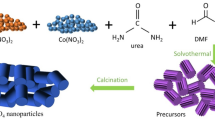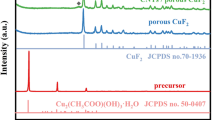Abstract
We report the preparation of porous CuO nanowires that are composed of nanoparticles (∼50 nm) via a simple decomposition of a Cu(OH)2 precursor and their application as the anode materials of rechargeable Na-ion batteries. The as-prepared porous CuO nanowires exhibit a Brunauer-Emmett-Teller (BET) surface area of 13.05 m2·g−1, which is six times larger than that of bulk CuO (2.16 m2·g−1). The anode of porous CuO nanowires showed discharge capacities of 640 mA·h·g−1 in the first cycle and 303 mA·h·g−1 after 50 cycles at 50 mA·g−1. The high capacity is attributed to porous nanostructure which facilitates fast Na-intercalation kinetics. The mechanism of electrochemical Na-storage based on conversion reactions has been studied through cyclic voltammetry, X-ray diffraction (XRD), Raman spectroscopy, and high resolution transmission electron microscopy (HRTEM). It is demonstrated that in the discharge process, Na+ ions first insert into CuO to form a Cu II1−x Cu I x O1−x/2 solid and a Na2O matrix then Cu II1−x Cu I x O1−x/2 reacts with Na+ to produce Cu2O, and finally Cu2O decompose into Cu nanoparticles enclosed in a Na2O matrix. During the charge process, Cu nanoparticles are first oxidized to generate Cu2O and then converted back to CuO. This result contributes to the design and mechanistic analysis of high-performance anodes for rechargeable Na-ion batteries.

Similar content being viewed by others
References
Berthelot, R.; Carlier, D.; Delmas, C. Electrochemical investigation of the P2-NaxCoO2 phase diagram. Nat. Mater. 2011, 10, 74–80.
Palomares, V.; Serras, P.; Villaluenga, I.; Hueso, K. B.; Carretero-González, J.; Rojo, T. Na-ion batteries, recent advances and present challenges to become low cost energy storage systems. Energy Environ. Sci. 2012, 5, 5884–5901.
Kim, D.; Kang, S.-H.; Slater, M.; Rood, S.; Vaughey, J. T.; Karan, N.; Balasubramanian, M.; Johnson, C. S. Enabling sodium batteries using lithium-substituted sodium layered transition metal oxide cathodes. Adv. Energy Mater. 2011, 1, 333–336.
Yabuuchi, N.; Kajiyama, M.; Iwatate, J.; Nishikawa, H.; Hitomi, S.; Okuyama, R.; Usui, R.; Yamada, Y.; Komaba, S.; Komaba. S. P2-type Nax[Fe1/2Mn1/2]O2 made from earth-abundant elements for rechargeable Na batteries. Nat. Mater. 2012, 11, 512–517.
Cao, Y. L.; Xiao, L. F.; Wang, W.; Choi, D.; Nie, Z. M.; Yu, J. G.; Saraf, L. V.; Yang, Z. G.; Liu, J. Reversible sodium ion insertion in single crystalline manganese oxide nanowires with long cycle life. Adv. Mater. 2011, 23, 3155–3160.
Saravanan, K.; Mason, C. W.; Rudola, A.; Wong, K. H.; Balaya, P. The first report on excellent cycling stability and superior rate capability of Na3V2(PO4)3 for sodium ion batteries. Adv. Energy Mater. 2013, 3, 444–450.
Cao, Y. L.; Xiao, L. F.; Sushko, M. L.; Wang, W.; Schwenzer, B.; Xiao, J.; Nie, Z. M.; Saraf, L. V.; Yang, Z. G.; Liu, J. Sodium ion insertion in hollow carbon nanowires for battery applications. Nano Lett. 2012, 12, 3783–3787.
Senguttuvan, P.; Rousse, G.; Seznec, V.; Tarascon, J.-M.; Palacín, M. R. Na2Ti3O7: Lowest voltage ever reported oxide insertion electrode for sodium ion batteries. Chem. Mater. 2011, 23, 4109–4111.
Darwiche, A.; Marino, C.; Sougrati, M. T.; Fraisse, B.; Stievano, L.; Monconduit, L. Better cycling performances of bulk Sb in Na-ion batteries compared to Li-ion systems: An unexpected electrochemical mechanism. J. Am. Chem. Soc. 2012, 134, 20805–20811.
Liu, Y. H.; Xu, Y. H.; Zhu, Y. J.; Culver, J. N.; Lundgren, C. A.; Xu, K.; Wang, C. S. Tin-coated viral nanoforests as sodium-ion battery anodes. ACS Nano 2013, 7, 3627–3634.
Su, D.; Ahn, H.-J.; Wang, G. X. SnO2@graphene nanocomposites as anode materials for Na-ion batteries with superior electrochemical performance. Chem. Commun. 2013, 49, 3131–3133.
Hariharan, S.; Saravanan, K.; Balaya, P. α-MoO3: A high performance anode material for sodium-ion batteries. Electrochem. Commun. 2013, 31, 5–9.
Klein, F.; Jache, B.; Bhide, A.; Adelhelm, P. Conversion reactions for sodium-ion batteries. Phys. Chem. Chem. Phys. 2013, 15, 15876–15887.
Alcántara, R.; Jaraba, M.; Lavela, P.; Tirado, J. L. NiCo2O4 spinel: First report on a transition metal oxide for the negative electrode of sodium-ion batteries. Chem. Mater. 2002, 14, 2847–2848.
Hariharan, S.; Saravanan, K.; Ramar, V.; Balaya, P. A rationally designed dual role anode material for lithium-ion and sodium-ion batteries: Case study of eco-friendly Fe3O4. Phys. Chem. Chem. Phys. 2013, 15, 2945–2953.
Kim, T. B.; Jung, W. H.; Ryu, H. S.; Kim, K. W.; Ahn, J. H.; Cho, K. K.; Cho, G. B.; Nam, T. H.; Ahn, I. S.; Ahn, H. J. Electrochemical characteristics of Na/FeS2 battery by mechanical alloying. J. Alloys Compd. 2008, 449, 304–307.
Zhang, W. X.; Li, M.; Wang, Q.; Chen, G. D.; Kong, M.; Yang, Z. H.; Mann, S. Hierarchical self-assembly of microscale cog-like superstructures for enhanced performance in lithium-ion batteries. Adv. Funct. Mater. 2011, 21, 3516–3523.
Zheng, S.-F.; Hu, J.-S.; Zhong, L.-S.; Song, W.-G.; Wan, L.-J.; Guo, Y.-G. Introducing dual functional CNT networks into CuO nanomicrospheres toward superior electrode materials for lithium-ion batteries. Chem. Mater. 2008, 20, 3617–3622.
Huang, H. W.; Liu, Y.; Wang, J. H.; Gao, M. X.; Peng, X. S.; Ye, Z. Z. Self-assembly of mesoporous CuO nanosheets-CNT 3D-network composites for lithium-ion batteries. Nanoscale 2013, 5, 1785–1788.
Wang, L. L.; Cheng, W.; Gong, H. X.; Wang, C. H.; Wang, D. K.; Tang, K. B.; Qian, Y. T. Facile synthesis of nanocrystalline-assembled bundle-like CuO nanostructure with high rate capacities and enhanced cycling stability as an anode material for lithium-ion batteries. J. Mater. Chem. 2012, 22, 11297–11302.
Zhang, J. T.; Liu, J. F.; Peng, Q.; Wang, X.; Li, Y. D. Nearly monodisperse Cu2O and CuO nanospheres: Preparation and applications for sensitive gas sensors. Chem. Mater. 2006, 18, 867–871.
Li, L. L.; Cheah, Y.; Ko, Y.; Teh, P.; Wee, G.; Wong, C.; Peng, S. J.; Srinivasan, M. The facile synthesis of hierarchical porous flower-like NiCo2O4 with superior lithium storage properties. J. Mater. Chem. A 2013, 1, 10935–10941.
Cheng, F. Y.; Wang, H. B.; Zhu, Z. Q.; Wang, Y.; Zhang, T. R.; Tao, Z. L.; Chen, J. Porous LiMn2O4 nanorods with durable high-rate capability for rechargeable Li-ion batteries. Energy Environ. Sci. 2011, 4, 3668–3675.
Zhang, X. L.; Cheng, F. Y.; Yang, J. G.; Chen, J. LiNi0.5Mn1.5O4 porous nanorods as high-rate and long-life cathodes for Li-ion batteries. Nano Lett. 2013, 13, 2822–2825.
Cheng, F. Y.; Zhao, J. Z.; Song, W. N.; Li, C. S.; Ma, H.; Chen, J.; Shen, P. W. Facile controlled synthesis of MnO2 nanostructures of novel shapes and their application in batteries. Inorg. Chem. 2006, 45, 2038–2044.
Ma, H.; Zhang, S. Y.; Ji, W. Q.; Tao, Z. L.; Chen, J. α-CuV2O6 nanowires: Hydrothermal synthesis and primary lithium battery application. J. Am. Chem. Soc. 2008, 130, 5361–5367.
Nan, C. Y.; Lu, J.; Li, L. H.; Li, L. L.; Peng, Q.; Li, Y. D. Size and shape control of LiFePO4 nanocrystals for better lithium ion battery cathode materials. Nano Res. 2013, 6, 469–477.
Yang, J. G.; Han, X. P.; Zhang, X. L.; Cheng, F. Y.; Chen, J. Spinel LiNi0.5Mn1.5O4 cathode for rechargeable lithiumion batteries: Nano vs micro, ordered phase (P4332) vs disordered phase \(\left( {Fd\bar 3m} \right)\). Nano Res. 2013, 6, 679–687.
Talyosef, Y.; Markovsky, B.; Lavi, R.; Salitra, G.; Aurbach, D.; Kovacheva, D.; Gorova, M.; Zhecheva, E.; Stoyanova, R. Comparing the behavior of nano- and microsized particles of LiMn1.5Ni0.5O4 spinel as cathode materials for Li-ion batteries. J. Electrochem. Soc. 2007, 154, A682–A691.
Debbichi, L.; Marco de Lucas, M. C.; Pierson, J. F.; Krüger, P. Vibrational properties of CuO and Cu4O3 from first-principles calculations, and Raman and infrared spectroscopy. J. Phys. Chem. C 2012, 116, 10232–10237.
Wang, P.; Ng, Y. H.; Amal, R. Embedment of anodized p-type Cu2O thin films with CuO nanowires for improvement in photoelectrochemical stability. Nanoscale 2013, 5, 2952–2958.
Chen, X.; Zhang, N. Q.; Sun, K. N. Facile fabrication of CuO mesoporous nanosheet cluster array electrodes with super lithium-storage properties. J. Mater. Chem. 2012, 22, 13637–13642.
Yuan, Z. Q.; Wang, Y.; Qian, Y. T. A facile room-temperature route to flower-like CuO microspheres with greatly enhanced lithium storage capability. RSC Adv. 2012, 2, 8602–8605.
Gao, H. Y.; Hu, Z.; Zhang, K.; Cheng, F. Y.; Chen, J. Intergrown Li2FeSiO4·LiFePO4-C nanocomposites as high-capacity cathode materials for lithium-ion batteries. Chem. Commun. 2013, 49, 3040–3042.
Duan, W. C.; Hu, Z.; Zhang, K.; Cheng, F. Y.; Tao, Z. L.; Chen, J. Li3V2(PO4)3@C core-shell nanocomposite as a superior cathode material for lithium-ion batteries. Nanoscale 2013, 5, 6485–6490.
Hu, Z.; Zhang, K.; Gao, H. Y.; Duan, W. C.; Cheng, F. Y.; Liang, J.; Chen, J. Li2MnSiO4@C nanocomposite as a high-capacity cathode material for Li-ion batteries. J. Mater. Chem. A 2013, 1, 12650–12656.
Zhang, K.; Zhao, Q.; Tao, Z. L.; Chen, J. Composite of sulfur impregnated in porous hollow carbon spheres as the cathode of Li-S batteries with high performance. Nano Res. 2013, 6, 38–46.
Hartmann, P.; Bender, C. L.; Vračar, M.; Dürr, A. K.; Garsuch, A.; Janek, J.; Adelhelm, P. A rechargeable room-temperature sodium superoxide (NaO2) battery. Nat. Mater. 2013, 12, 228–232.
Débart, A.; Dupont, L.; Poizot, P.; Leriche, J.-B.; Tarascon, J. M. A transmission electron microscopy study of the reactivity mechanism of tailor-made CuO particles toward lithium. J. Electrochem. Soc. 2001, 148, A1266–A1274.
Author information
Authors and Affiliations
Corresponding author
Additional information
These two authors contributed equally to this work.
These two authors contributed equally to this work.
Electronic supplementary material
Rights and permissions
About this article
Cite this article
Wang, L., Zhang, K., Hu, Z. et al. Porous CuO nanowires as the anode of rechargeable Na-ion batteries. Nano Res. 7, 199–208 (2014). https://doi.org/10.1007/s12274-013-0387-6
Received:
Accepted:
Published:
Issue Date:
DOI: https://doi.org/10.1007/s12274-013-0387-6




